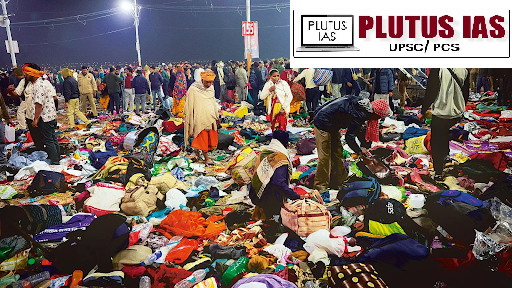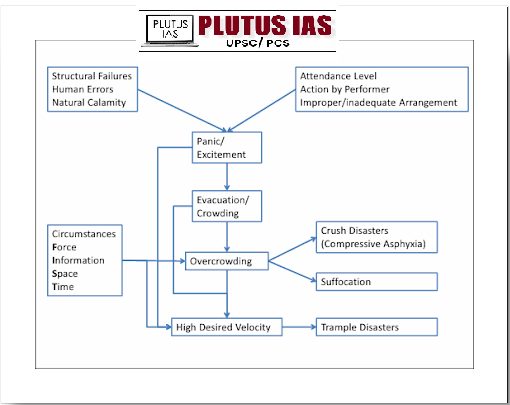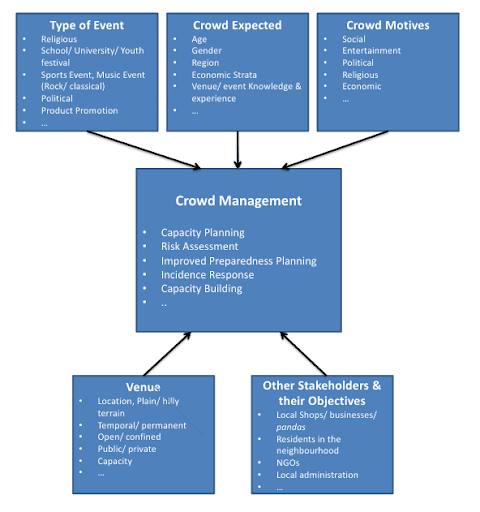01 Feb Crowd Disaster: The Unnoticed Yet Deadly Disaster
This article covers “Daily Current Affairs,” and the topic details related to “Crowd Disaster: The Unnoticed Yet Deadly Disaster”
Syllabus mapping:
GS-3: Disaster Management: Crowd Disaster: The Unnoticed Yet Deadly Disaster
For Prelims:
What are the Crowd management-related disasters and provisions of the NDMA Act,2005
For mains:
What are the factors leading to the stampede, what are the legal provisions, and how to manage the large crowd gatherings?
Why in the News?
A deadly stampede occurred at the Maha Kumbh Mela in Prayagraj, resulting in dozens of fatalities. The tragedy took place before dawn as millions of devotees gathered to take a ritual dip in the sacred river on the festival’s most auspicious day. The massive crowd surge led to chaotic conditions, highlighting ongoing concerns about crowd management and safety at large religious gatherings.

What is a Crowd Disaster?
A crowd disaster is a tragic event where a large number of people suffer injuries or fatalities due to high crowd density, often leading to stampedes or crushes. These incidents typically occur at large gatherings such as religious pilgrimages, concerts, sporting events, or public demonstrations.
Recent Crowd Disasters in India:
| Sr. No. | Place & Date of Disaster | Cause of Disaster | Casualties |
|---|---|---|---|
| 1 | Charbagh Railway Station, Lucknow, Uttar Pradesh (28 Sept 2002) | Stampede on stairs | 19 |
| 2 | Nashik Mahakumbh Mela, Maharashtra (27 Aug 2003) | Religious gathering stampede | 29 |
| 3 | Wai, Satara, Shri Kalubai Yatra, Maharashtra (25 Jan 2005) | Stampede during religious event | 293 |
| 4 | Naina Devi Temple, Bilaspur, Himachal Pradesh (3 Aug 2008) | Stampede at temple | 162 |
| 5 | Chamunda Devi Temple, Jodhpur, Rajasthan (30 Sept 2008) | Stampede at temple | 249 |
| 6 | Ramjanaki Temple, Pratapgarh, Uttar Pradesh (4 Mar 2010) | Religious gathering stampede | 65 |
| 7 | Sabarimala Stampede, Kerala (14 Jan 2011) | Religious pilgrimage | 102 |
| 8 | Allahabad Railway Station, Uttar Pradesh (10 Feb 2013) | Stampede during Maha Kumbh Mela | 36 |
| 9 | Ratangarh, Datia, Madhya Pradesh (13 Oct 2013) | Stampede on bridge due to railing collapse | 121 |
| 10 | Maha Kumbh, Prayagraj, Uttar Pradesh (29 Jan 2025) | Religious gathering stampede | 30 |
Causes of Crowd Disasters

High Crowd Density: When the number of people per square meter exceeds safe limits, movement becomes restricted, leading to crushing. Densities above 5 people per square meter pose a risk, and above 7 people per square meter can be fatal.
Poor Crowd Management: Ineffective planning for large crowds, lack of barriers, or improper entry/exit routes can cause dangerous congestion.
Sudden Surges and Panic: Fear-driven reactions, such as rumors or perceived threats, can trigger mass movement, leading to stampedes.
Blocked or Narrow Exits: Insufficient escape routes or bottlenecks force people into tighter spaces, increasing pressure and risk of injury.
Structural Failures: Weak or collapsing infrastructure (e.g., fences, bridges, or temporary stands) can cause chaos and panic.
Environmental Factors: Poor weather conditions, extreme heat, or limited air circulation can worsen crowd distress and lead to medical emergencies.
Lack of Emergency Response: Delayed or ineffective emergency services can increase casualties in case of an incident.
Key Legal Provisions for Crowd Management
| Act | Relevant Provisions | Objective for Crowd Control |
|---|---|---|
| Disaster Management Act, 2005 | Controls traffic in vulnerable areas (Sec 24, 34). Authorizes officials for disaster management (Sec 33). Penalizes obstruction, false claims, and violations (Sec 51-53, 58). |
Ensures proactive disaster management and penalizes negligence. |
| Police Act, 1861 | Deploys additional police in disturbed areas (Sec 15). Regulates public assemblies and processions (Sec 30, 30A). |
Empowers law enforcement for crowd control. |
| Madras City Police Act, 1888 | Mandates licensing for public places (Sec 34). Regulates meetings and processions (Sec 41, 41A). |
Ensures orderly conduct in public spaces. |
| Kerala Police Act, 2011 | Regulates traffic in disturbed areas (Sec 45). Controls public assemblies for safety (Sec 79). |
Enhances preventive security measures. |
| UP Melas Act, 1938 | Manages crowd flow at religious fairs (Sec 6-10). | Ensures safety at large religious gatherings. |
| Cinematograph Act, 1952 | Mandates safety measures in theaters (Sec 10-12). | Controls crowd size in entertainment venues. |
| Delhi Cinematograph Rules, 1953 | Regulates seating, exits, and fire safety. | Ensures safe crowd management in theaters. |
Ways to Prevent Crowd Disasters:

Maintain Safe Crowd Density: Ensure the number of people per square meter does not exceed safe limits. Monitor crowd movement and prevent dangerous congestion.
Improve Entry and Exit Management: Increase the number of entry and exit points to prevent bottlenecks. Stagger arrival and departure times to reduce sudden crowd surges.
Use Physical Barriers and Crowd Segmentation: Divide large crowds into smaller, manageable sections to prevent uncontrolled movement. Implement zoning strategies like those used in Times Square on New Year’s Eve.
Ensure Clear Pathways: Keep all walkways free from obstacles that could cause people to trip or get trapped. Maintain emergency escape routes that are well-marked and accessible.
Use Technology for Crowd Monitoring: Deploy CCTV, drones, and AI-powered crowd density tracking to detect dangerous levels early. Implement real-time communication systems to provide crowd guidance.
Enforce Stronger Regulations: Governments should pass laws mandating safety measures at large events. Event organizers should be held accountable for implementing proper crowd management strategies.
Prioritize Safety Over Profit: Avoid maximizing crowd size for financial gain at the expense of safety. Balance economic interests with necessary safety protocols.
Download Plutus IAS Current Affairs (Eng) 1st Feb 2025
Conclusion
Crowd disasters are not random accidents but preventable tragedies. While individual crowd members have little control over large-scale movements, event planners, local governments, and venue operators have the power to enforce safety measures. By implementing simple, cost-effective strategies, they can significantly reduce risks and save lives. Ignoring these precautions will only lead to further unnecessary human life loss in the future.
Prelims Question:
Q. Which of the following are classified as disasters under the Disaster Management Act,2005?
1. Industrial Fire incident
2. Stampede
3. Urban floods
Select the correct answer using the code given below:
(a). 1 and 2 only
(b). 2 and 3 only
(c). 1 and 3 only
(d). 1, 2 and 3
ANSWER: D
Mains Question:
Q. Recent incidences of stampedes and casualties highlight the need for effective crowd management. Comment.
(Answer in 150 words)




No Comments